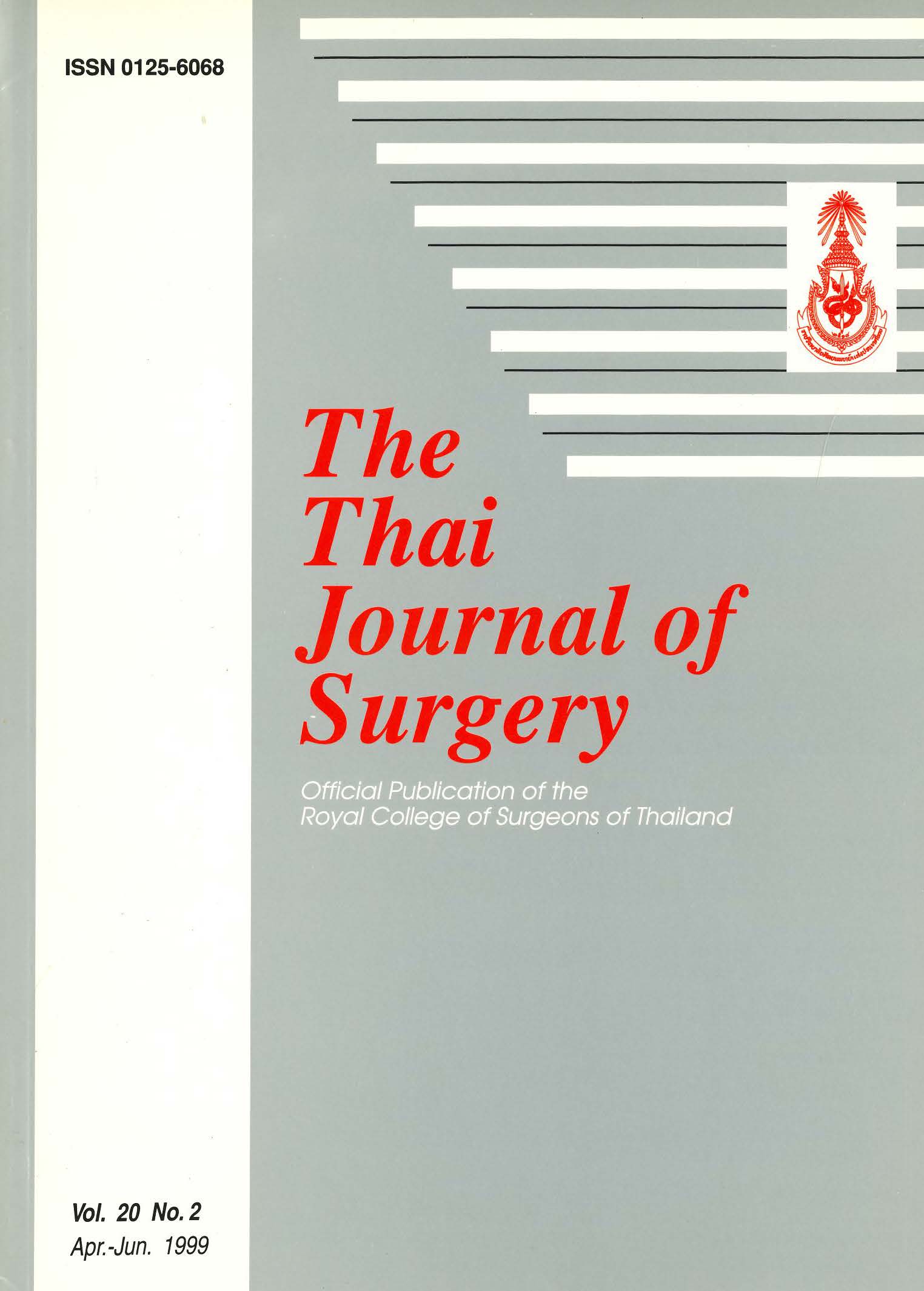Appendiceal Mass: Interval Appendectomy Should Not Be the Rule
Abstract
Introduction: An appendiceal mass is the end result of a walled-off appendiceal perforation and occurs in 2 to 6 per cent of patients with appendicitis, Conservative treatment with intravenous antibiotics remains the standard approach. In the past, interval appendectomy was recommended to prevent repeated episodes of acute appendicitis which occurred in 10 to 20 per cent of patients mostly during the first year after the initial attack. Theoretically, routine elective interval appendectomy may be safely omitted in more than 80 per cent of patients.
Research design: Retrospective descriptive study.
Setting: University Hospital.
Patient selection: All patients clinically diagnosed with an appendiceal mass in Department of Surgery, Faculty of Medicine, King Chulalongkorn Memorial Hospital between January 1993 and December 1998.
Method: The medical records were reviewed case by case. The patients were classified into 2 groups. Appendectomy was performed in group 1. The patients who did not return for appendectomy (group 2) were asked for any symptoms suggesting recurrent appendicitis either by phone or by letter. The rate of recurrent appendicitis after initial conservative management is the main outcome.
Results: Appendiceal mass was diagnosed in 82 patients over the 6-year period in which the study was retrospectively reviewed. Their age ranged from 3 to 87 years (mean 37 years), the duration of symptoms ranged from 1 to 20 days (mean, 5.73 days). The diagnosis was confirmed by ultrasonography in 10 patients. Almost all patients received initial conservative management and scheduled for interval appendectomy. Interval appendectomy was performed in 43 patients, 5 of them (6.17%) had recurrence of symptoms before surgery, Immediate appendectomy without initial conservative treatment was done in one patient. The remaining 38 patients did not come back for appendectomy, 4 patients were lost to follow-up. No recurrent appendicitis was found in this group of patients.
Conclusion: Routine interval appendectomy is unnecessary in more than 80 per cent of patients. Appendectomy should be done only when the symptoms recur.
References
2. Nitecki S, Assalia A, Schein M, Contemporary management of the appendiceal mass. Br J Surg 1993; 80:18-20.
3. Lewin J, Fenyo G, Engstrom L. Treatment of appendiceal abscess. Acta Chir Scand 1988; 154:123-5.
4. Price MR, Haase GM, Sartorelli KH, Meagher DP. Recurrent appendicitis after initial conservative management of appendiceal abscess. J Pediatr Surg 1996; 31:291-4.
5. Hoffmann J, Lindhard A, Jensen HE. Appendix mass: conservative management without interval appendectomy. Am J Surg 1984; 148:379-82.
6. Baji P, Dueholm S, Karstruo S. Percutaneous drainage of appendiceal abscess: an alternative method to conventional treatment. Dis Colon Rectum 1987;30:532-5.
7. Mozziotti MV, Marley EF, Winthrop AL, Fitzgerald PG, Walton M, Langer JC. Histopathological analysis of interval appendectomy specimens: support for the role of interval appendectomy. J Pediatr Surg 1997; 32:806-9.
8. Adalla S. Appendiceal mass: interval appendectomy should not be the rule. Br J Clin Prac 1996; 50:168-9.
9. Ein SH, Shandling B. Is interval appendectomy necessary after rupture of an appendiceal mass? J Pediatr Surg 1996;31:849-50.
10. Eriksson S, Styrud J. Interval appendectomy: a retrospective study. Eur J Surg 1998; 164:771-4.
Downloads
Published
How to Cite
Issue
Section
License
Articles must be contributed solely to The Thai Journal of Surgery and when published become the property of the Royal College of Surgeons of Thailand. The Royal College of Surgeons of Thailand reserves copyright on all published materials and such materials may not be reproduced in any form without the written permission.



